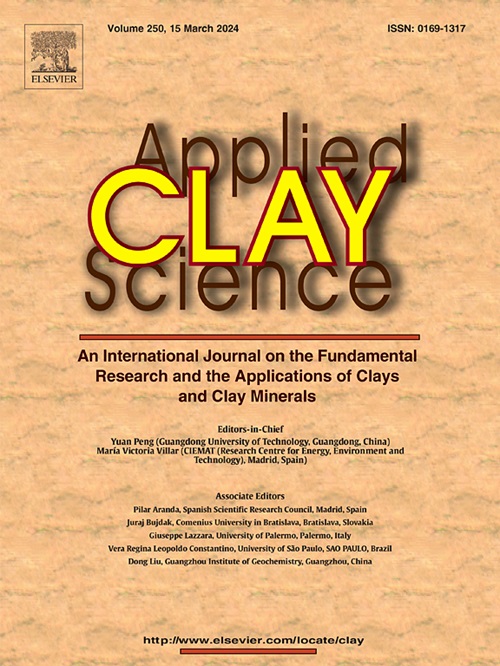Stabilization of chemically flexible indigo dye against photodegradation under solvent condition through intercalation into layered double hydroxide
IF 5.3
2区 地球科学
Q2 CHEMISTRY, PHYSICAL
引用次数: 0
Abstract
An indigo derivative with a flexible structure and water solubility was synthesized and further stabilized in a layered double hydroxide. Although the synthesized indigo derivative takes advantage of high water-solubility thanks to hydrophilic carboxymethyl groups, its stability in water was significantly low showing 91 % decomposition even in a dark environment. Under light irradiation, the indigo derivative became more fragile, being subjected to both photoisomerization and photodecomposition simultaneously. In order for stabilization under water conditions, the indigo derivative was hybridized with a layered double hydroxide by intercalation. The hybrid exhibited significant stability in a water suspension for more than 2 days under darkness and for 5 h even with 660 nm light irradiation. The stability was thought to be due to the isolation of the indigo derivative from the solvents and suppression of its trans-cis isomerization by the confinement effect in the interlayer space of the layered double hydroxide.

层状双氢氧化物对化学柔性靛蓝染料在溶剂条件下抗光降解的稳定性研究
合成了一种具有柔性结构和水溶性的靛蓝衍生物,并在层状双氢氧化物中进一步稳定。虽然合成的靛蓝衍生物由于亲水性羧甲基而具有高水溶性,但其在水中的稳定性很低,即使在黑暗环境下也能分解91%。在光照射下,靛蓝衍生物变得更加脆弱,同时发生光异构和光分解。为了在水条件下稳定,靛蓝衍生物通过插层法与层状双氧根杂化。该杂交种在水悬浮液中表现出明显的稳定性,在黑暗条件下持续2天以上,在660 nm光照射下持续5小时。这种稳定性被认为是由于靛蓝衍生物从溶剂中分离出来,并通过层状双氢氧化物层间空间的限制效应抑制了其反顺异构化。
本文章由计算机程序翻译,如有差异,请以英文原文为准。
求助全文
约1分钟内获得全文
求助全文
来源期刊

Applied Clay Science
地学-矿物学
CiteScore
10.30
自引率
10.70%
发文量
289
审稿时长
39 days
期刊介绍:
Applied Clay Science aims to be an international journal attracting high quality scientific papers on clays and clay minerals, including research papers, reviews, and technical notes. The journal covers typical subjects of Fundamental and Applied Clay Science such as:
• Synthesis and purification
• Structural, crystallographic and mineralogical properties of clays and clay minerals
• Thermal properties of clays and clay minerals
• Physico-chemical properties including i) surface and interface properties; ii) thermodynamic properties; iii) mechanical properties
• Interaction with water, with polar and apolar molecules
• Colloidal properties and rheology
• Adsorption, Intercalation, Ionic exchange
• Genesis and deposits of clay minerals
• Geology and geochemistry of clays
• Modification of clays and clay minerals properties by thermal and physical treatments
• Modification by chemical treatments with organic and inorganic molecules(organoclays, pillared clays)
• Modification by biological microorganisms. etc...
 求助内容:
求助内容: 应助结果提醒方式:
应助结果提醒方式:


